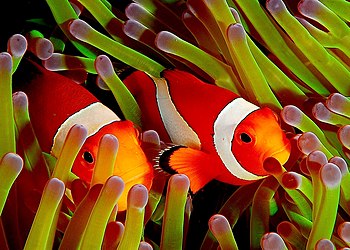As a marine aquarium enthusiast, you will have you veritable pick of the litter when it comes to species selection for your tank. The only limiting factor in most cases is the size of your aquarium and the size of your budget. Some are common and cheap while others are rare and expensive. Below we take a look at the most popular choices for marine hobbyists today.
 |
| LARGER On Black Ocellaris clownfish, Amphiprion ocellaris. Some clown anemonefishes are brave. When divers close to them, papa anemonefish will swim out to defense. (Looks like very angery!!) But, oftenly they will hide.(papa will hide faster than their babies. haha~) Lovely!! (Photo credit: Wikipedia) |
At the top spot, we have the familiar amphiprion ocellaris in addition to amphiprion percula. These are most widely recognized clownfish in the hobby in addition to being the most popular ornamental saltwater fish on the market. Some of you might have seen finding nemo, where the species is well represented. However, to most saltwater hobbyists they are simply identified as the false percula and the true percula.
They look almost entirely identical with the difference being the number of dorsal spines present. Amphiprion Ocellaris is a cheap fishes that is a staple in the industry. Amphiprion percula commands a higher price along with is less common than its recognizable cousin. They both do well in the aquarium and are good selections for experienced or new enthusiasts.
The yellow tang in addition to the blue tang fill in the second spot. They are a recognizable choice on posters and a variety of saltwater aquarium products on the market. The blue tang also had some air time on the animated movie, Finding Movie. There, she was identified as the clumsy Dory. Blue tangs are usually cheaper than yellow tangs as they are imported in huge quantities.
They are both great candidates for captive life if they have ample room to swim in addition to are treated for any parasites that came in with them during shipment. Like It must be noted however that all tangs are susceptible to lateral line erosion plus particularly marine ich. Ensure they are given a diet that is rich in greens as they are algae grazers in the wild.
Finally, four angelfish make up the last spot. They are the dwarf flame angelfish, French angelfish, emperor angelfish as well as the stunning queen angelfish. These four always get top demand from the marine community. They are the most costly recognizable fishes in this article. For very large, show quality specimens of queen angelfish, french angelfish plus emperor angelfish, expect to pay hundreds per specimen.
Flame angelfish usually cost less than their larger sized brethren. But that does not reflect on its beauty as it is easily on of the most stunning members of the family centropyge. They should be fed a well rounded diet that includes seafood as well as seaweed plus algae. For the most part, angels are not reef safe so do not house them with corals. However, you're bound to have more luck with the dwarf angelfish family in this respect.
Additional information on the popular Clown fish species of fish can be found at the authors hubpage. Should you need information on specific fish like the Amphiprion Percula which is the nemo fish, don't hesitate to pay us a visit for a full guide including breeding behavior, care and requirements, photographs and videos. Article Source: EzineArticles |




